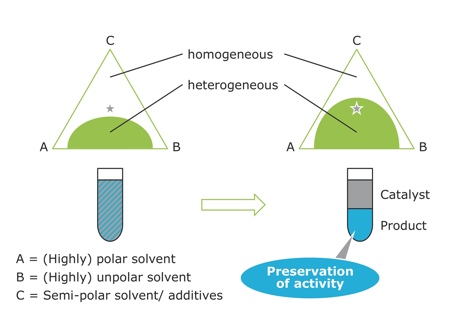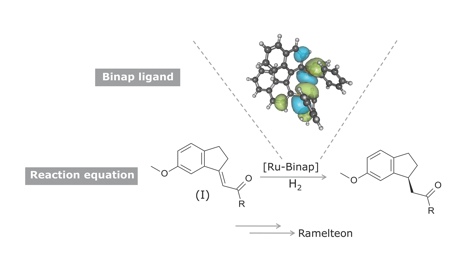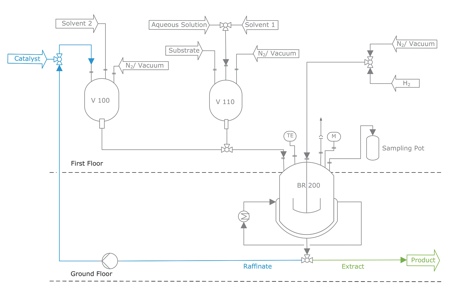Chiral active pharmaceutical ingredients (APIs) play an important role in the pharmaceutical and fine chemical industry. The global demand for these chemicals is increasing and consequently, there is a need for more efficient and sustainable methods for their production. The world is becoming more complex – as are the challenges it faces. Often experts from various fields have to co-operate to find innovative solutions and as a result, knowledge management is increasingly important for manufacturers in the pharmaceutical industry.
A good example of the very specific knowledge that can be shared to produce a new and better process is the reactivation of homogeneous chiral catalyst complexes after contact with water and reactions in liquid/liquid multi-phase systems.
Manufacturers of APIs face several challenges, including the increasingly stringent regulation of the market and the desire for more sustainable production. These circumstances require innovation and research into new approaches. Former scientists from Technische Universität Berlin and Max Planck Institute now form the development team of DexLeChem. This German spin-off from the Cluster of Excellence Unifying Concepts in Catalysis (UniCat) has developed a sustainable and economic method for the production of APIs.
Traditionally the problem has been that homogeneous chiral catalysts are generally disposed of after one batch because they decompose at rather low temperatures that are exceeded during standard distillation procedures.
The application of aqueous solutions and other sustainable solvents enables the re-use of unmodified catalysts
One answer is the application of aqueous solutions and other sustainable solvents, which enables the re-use of unmodified catalysts. The trick is to carry out catalytic reactions in thermomorphic solvent systems and to apply specific reactivation strategies of the catalysts. In this way DexLeChem has successfully used several chiral biaryldiphosphine ligands in aqueous based thermomorphic solutions.
By applying a specific temperature, the mixture of the different solvents forms one homogeneous solvent phase in which the catalytic reaction can take place. If the temperature is reduced, the thermomorphic system is transformed into two separated liquid/liquid phases.
When choosing an appropriate solvent system, it is preferable that the catalyst remains in one phase and the product in the other phase. Hence a gentle separation can be achieved. The phase containing the catalyst can be reused for a subsequent reaction. After separation and addition of new reactants the temperature is increased to re-establish the state with one homogeneous solvent phase so that a further catalytic reaction can take place.

Figure 1: Thermomorphic solvent systems
To reactivate the sensitive catalytic cycle after contact with water, and to obtain a higher degree of product/catalyst separation, it can be crucial to add the right additive (Figure 1).

Figure 2: A key step in the synthesis of Ramelteon in which the C=C double bond of the substrate (I) is enantioselectively hydrogenated using an unmodified ruthenium Binap catalyst
This method was successfully applied in the synthesis of the key intermediate of Ramelteon, a drug that is used in the treatment of sleeping disorders. The C=C double bond of the substrate (I) is enantioselectively hydrogenated using an unmodified ruthenium Binap catalyst (see Figure 2). A schematic of the recycling plant is also shown in Figure 3.

Figure 3: Plant for reusing the unmodified chiral catalyst
API preparation
The enantioselective hydrogenation of substrate (I) is performed in an autoclave under H2 atmosphere. For all experiments the whole setup must be evacuated and purged by N2 several times. All compounds must be oxygen-free as well.
The catalyst is given to the organic solvent 2 in the catalyst preparation vessel V100 and stirred for 30 minutes (see Figure 3). Substrate (I) is dissolved in vessel V110 in a mixture of the semi-polar solvent 1 and an aqueous solution.
Enantioselective hydrogenation reaction (first batch):
The catalyst solution and the substrate solution are transferred to the batch reactor BR200. After heating this reaction mixture up to 70°C, 50 bar hydrogen is added and dispersed well. Samples are taken and analysed via chiral high performance liquid chromatography (HPLC) and nuclear magnetic resonance (NMR) spectroscopy. After 180 minutes the reaction is stopped by cooling and releasing H2. The overall yield of the reaction is >96 % and the enantiomeric excess (ee) is 98 % of the (S)-Enantiomer.
Re-use of the catalyst
Separation and enantioselective hydrogenation reaction (second batch):
To the solution of the single batch experiment another aqueous solution is added from vessel V110 to the reactor BR200. The mixture is cooled and stirred for approximately three minutes, the stirrer is stopped finally and a biphasic liquid/liquid system is obtained. After 10 minutes the raffinate – the organic phase (catalyst phase) – is purged into the vessel V100 while the extract – the aqueous phase (containing the product) – is collected from the autoclave and further purified.
By applying this method, 95% of the chiral catalyst could be re-used, while the yield and the enantioselectivity remained the same
In the next step, new substrate (I) is dissolved in vessel V110 in a mixture of semi-polar solvent 1 and an aqueous solution and transferred to the reactor again. After reaching 70°C in the autoclave the new run is started by the addition of 50 bar H2. The reaction is stopped after three hours and the conversion as well as the purity of the product is determined via chiral HPLC and NMR spectrometry. Thus, the second batch can be directly compared with the first batch.
By applying this method, 95% of the chiral catalyst could be re-used, while the yield and the enantioselectivity remained the same (96% and 98% ee, respectively).
A reactivation of the water-sensitive chiral catalysts during the reactions has been obtained through different additives.
A small team of experts from theoretical physics, chemical engineering and catalysis developed this production process in two and a half months. They applied laboratory experiments and a combination of various levels of theory (e.g. quantum chemical methods) that enabled the determination of the thermodynamic properties as well as microscopic details, such as the geometric and the electronic structure of catalytic complexes.
This innovative process involving aqueous solutions and re-use of the chiral catalysts has significant advantages over former processes: APIs can be produced in a more cost-efficient manner and in a more environmentally benign way compared with the former state-of-the-art.




